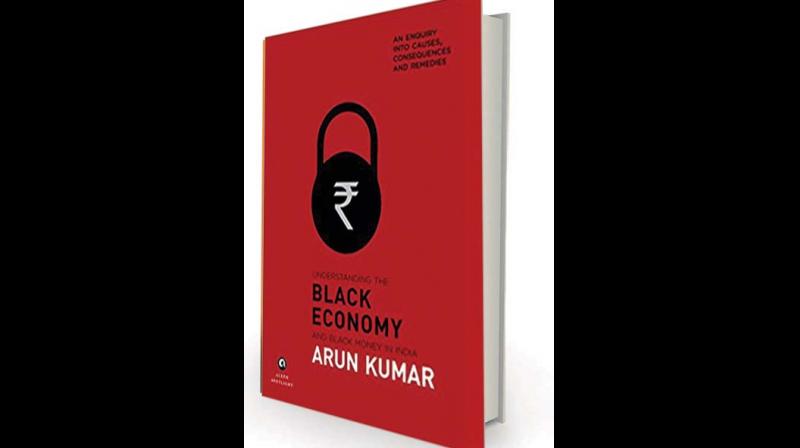Book Review 'Understanding the Black Economy and Black Money in India'
On the remedies for black money, the author proposes strengthening the implementation of various rules and laws as a short-term measure.

What sense do you make of Prime Minister Modi’s recent demonetisation exercise to tackle the problem of black money in India? Well, almost everybody agrees that it has imposed short-term costs on the nation. But when it comes to understanding its longer term effects, the reaction of experts is wide-ranging: from being at loss of words to talking in unclear terms, from being uncertain about its effects to taking contradictory position and so forth. The common man is utterly confused. The book is all about making the common man, even an expert, gain a perspective on the issue of black economy in India as well as on the recent demonetisation exercise.
While being fully supportive of the reason behind the recent demonetisation exercise, Arun Kumar takes a grim view of its effects in tackling corruption and black economy. Why? Because it fails to hit the problem at its core which, according to the author, is to be found in the triad of corrupt businessmen, politicians, and executive (the police, bureaucracy, and judiciary).
Taking a historical view of the origins and growth of black economy in India, the author believes that it was neither the fact of “licence-permit raj” of yesteryears nor its dismantling post-1991, the root cause of the growth of black money in the country. Nor were other factors such as high tax rates or high rate of inflation and speculation. A factor common to both the eras is “the triad” that has only become more powerful overtime with criminals and media in the nexus. While the era of controls and regulations created “rent seeking” opportunities that were exploited by the triad, the era of deregulation saw an increase in illegality and crime due to systematic violation of rules and laws. A little wonder then that corruption and black money has only grown overtime as evidenced by the rapid unearthing of more and bigger scams. India’s black economy is estimated to be 62 percent of GDP generating (at 2017-17 prices) about Rs 93 lakh crores!
A good understanding of the subject is essential if well-meaning efforts to tackle the generation of black money have to succeed. In Black Economy..., the author explains at some length the phenomenon of generation of black money and gets into the methods and measurement of it. He brings out differences in the terms and concepts used. For example, black money and black economy cannot be used interchangeably as these are two distinct notions; and black economy is not a parallel economy but is intertwined with white economy as the same economic activity often generates both black and white income. Similarly, both formal sector and informal sectors generate black incomes, and that it’s not only illegal activities that generate black income but “illegality” committed in legal activities, resulting in tax evasion, too generates black income. Further, the author dispels several common misconceptions about the subject. For instance, black economy and corruption, though positively correlated, are not synonymous, and
is not a matter solely concerning the public sector; it affects the private sector too and so forth.
Often some people tend to give a positive spin to the issue of black money. They argue that, after all, black money also creates employment and generates income for some, and the larger the black economy the larger is the size of actual economy. But nothing is further from the truth. The author puts this argument also in perspective. The author makes a convincing case of how the black money is holding back India’s growth and development. As per some estimates, had it not been for the black economy, India would have become world’s second largest economy and every Indian, on average, would have been seven times richer than what it is today.
A presence of large black economy not only blunts the policy instruments available to the government to exercise control over the economy but also deprives the government of the much needed revenues to finance the provision of essentials services such as healthcare, education, maintenance of law and order and so forth. When citizens have to pay for these services that they expect from government, there is a pressure on citizens to make more money which gives rise to a vicious circle of illegality, which in turn, boosts black economy. The author cites several examples from different walks of life to drive home this point. When roads are poorly constructed, when teachers or doctors are absent from the institutions they are supposed to be in, when water quality is poor and so on, it not only lead to social waste but also reduce the effectiveness of public investments. When one takes account of both the direct and indirect effects of black money, the losses to the society are huge.
On the remedies for black money, the author proposes strengthening the implementation of various rules and laws as a short-term measure, targeting the changes in sectoral policies as a medium term measure, and undertaking structural reforms as a longer term measure. More specifically, implementing right to information act in earnest and appointing Lokpal, enforcing penalties, upholding rule of law, granting autonomy to institutions are some of the short term measures. Carrying out the urgently needed reforms of the executive comprising the police, the bureaucracy, and the judiciary, are some of the medium-term measures. Reforming the functioning of political parties, bringing electoral reforms, strengthening accountability in the corporate sector are some of the longer term measures. The key idea behind these reforms is to make the institutions, the government, and the powerful truly accountable, which in effect is asking for a social movement that will force this change.
In this short, kindle-size book of 112 pages, the author manages to bring out many interesting facets of black money in India and make some very compelling arguments. Even if one’s doesn’t necessarily agree with all the arguments and conclusions, it is an insightful read. A largely non-technical tone of the book makes this topic easily comprehensible even to the lay person interested in this topic.

